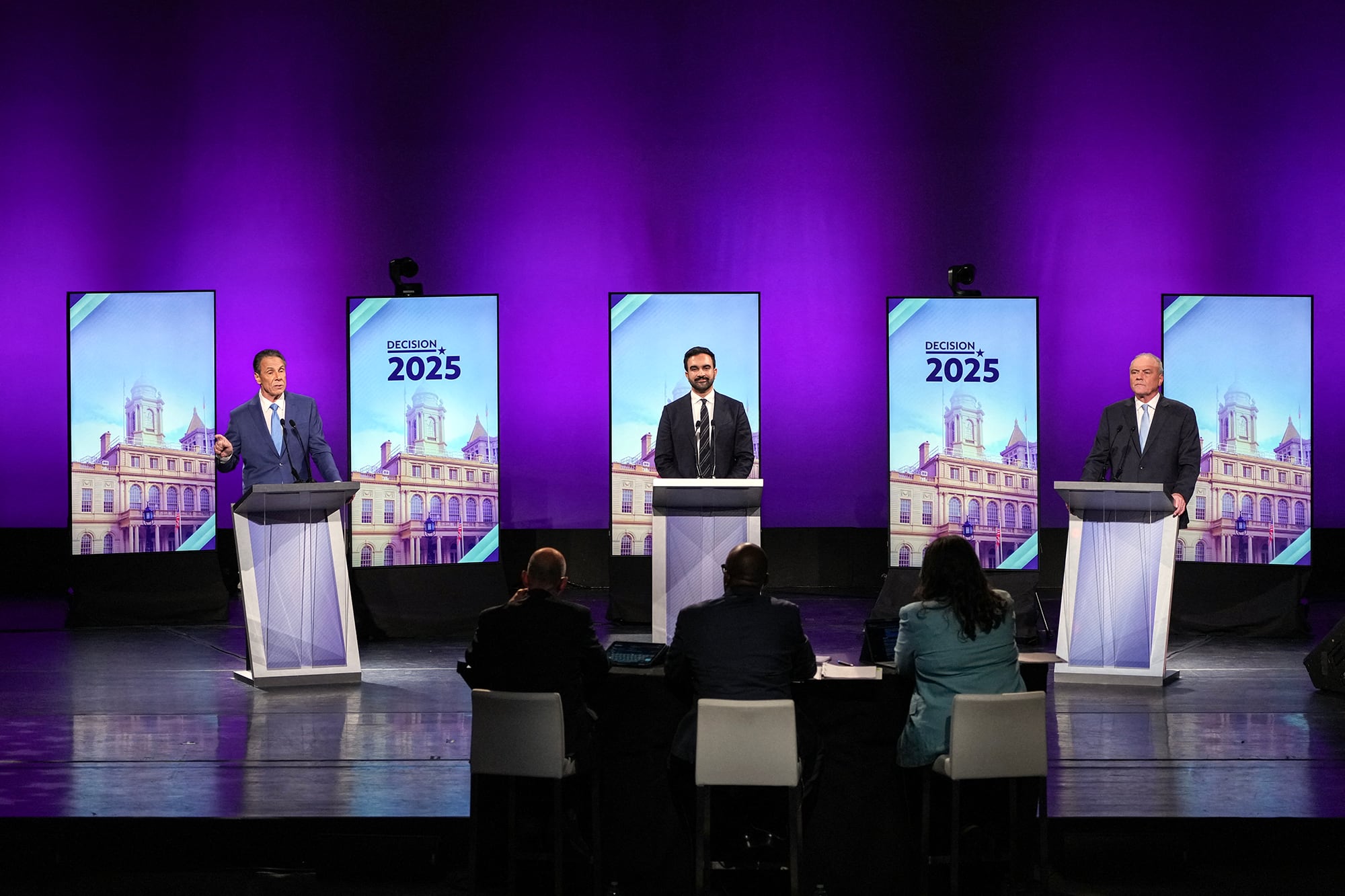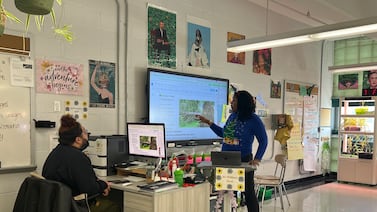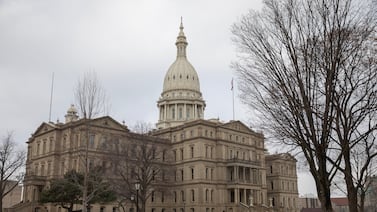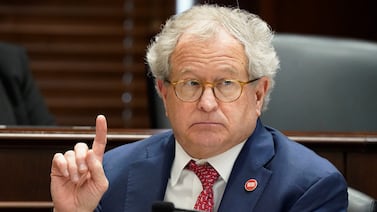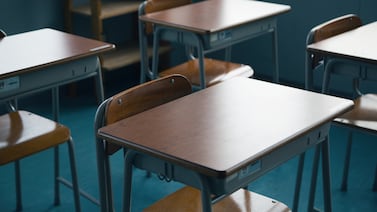Sign up for Chalkbeat New York’s free daily newsletter to get essential news about NYC’s public schools delivered to your inbox.
New York City’s next mayor will oversee the nation’s largest school system: more than 1,600 schools serving roughly 900,000 students with about 150,000 employees.
Its $40 billion budget makes it the largest city agency.
And yet, the candidates have not made education a central theme.
Democratic nominee Zohran Mamdani’s affordability agenda includes free child care, but he has a slim K-12 platform. He’s offered some hints that he’d want to focus on the system’s most vulnerable children, including students with disabilities and the growing number of homeless students. A record high of the city students — 154,000 — lived last year in shelters or doubled up in homes with friends or family.
Former Gov. Andrew Cuomo, who is running as an independent, has positioned himself as the champion of selective admissions, calling for doubling specialized high schools and expanding gifted and talented programs — both of which serve a fraction of the city’s students and disproportionately enroll white and Asian American children.
And Republican candidate Curtis Sliwa vowed to slash $10 billion from the Education Department’s budget, roughly 42% of how much the city spends on schools. (Mamdani has also called for tackling wasteful department spending.)
Perhaps the most consequential education idea Mamdani has espoused about the city’s school system: having less control over it.
Here’s a closer look at some of the educational issues that have come up on the campaign trail.
What might the future of mayoral control look like?
Ever since Michael Bloomberg won sweeping control over the school system in 2002, including the power to appoint the schools chancellor, every mayor has lobbied state lawmakers to keep this governance model in place.
Mayoral control’s supporters say it creates a clear line of accountability: The buck stops with the mayor, who wields enormous influence over the Education Department’s budget.
Mamdani has vowed to “end” mayoral control, embracing a longstanding critique that it gives little say to parents and educators on decisions that directly affect them. The frontrunner has promised a system of “co-governance” with existing parent councils and school-level leadership teams, though has offered scant details on how that would work.
At the same time, he has said, the mayor should still be held accountable for the public school system — raising questions about how much power he is willing to relinquish.
“I remain opposed to mayoral control, and I also believe that the mayor is accountable for that which happens in this city,” Mamdani said in this week’s debate.
Both of Mamdani’s opponents support mayoral control.
Cuomo recently said it would be a “terrible mistake” to roll it back.
“That’s probably been the most dramatic educational reform in 40 years,” Cuomo said. “We’d go back to the old system that had local school boards, which were corrupt patronage mills.”
Whoever is elected must soon negotiate with state lawmakers over mayoral control, which is up for renewal in 2026. (It’s typically extended every couple years.)
How will the city meet the challenges to shrink classes?
Over the next two years, all New York City public school classrooms must be capped between 20-25 students under a state law. That will require thousands of new teachers, billions of dollars, and thorny tradeoffs at overcrowded campuses.
Mamdani, who was endorsed by the United Federation of Teachers, recently unveiled a plan to recruit 1,000 teachers a year by offering tuition assistance in exchange for a three-year teaching commitment. The $12 million plan won’t be enough to fully staff smaller classes, Mamdani acknowledged. To speed up the process of building new classroom space, he has also called for filling vacancies at the School Construction Authority, the agency overseeing such projects.
During the primary, Cuomo expressed support for the class size law, though he cautioned it would be difficult to implement without an infusion of new funding from the state. In recent weeks, however, the former governor’s tone has shifted considerably. In a town hall meeting with parent leaders last month, he decried the law as “detached from reality” and “reckless.”
“It is an impossibility without funding,” Cuomo said. Sliwa shares that position.
What will happen to Mayor Eric Adams’ curriculum mandates?
Mayor Eric Adams’ main educational agenda has focused on overhauling reading and math instruction. All elementary campuses must now use city-approved reading curriculums. High schools transitioned to a standard Algebra 1 program. A growing number of middle schools must use city-approved literacy and math programs, too.
In a rare instance of agreement, the candidates have said they generally support the reading curriculum changes. Cuomo has raised concerns about whether the mandated math curriculums are as strong. Mamdani said teachers should have more control over how the curriculums are implemented.
Yet in a recent debate, Mamdani took a more pessimistic tone on the reading curriculum changes — and the school system more broadly.
“We are not even on track to ensure greater literacy levels across those schools, despite the strides that have been taken with NYC Reads,” Mamdani said. (Reading scores ticked up on the latest state tests, though it’s unclear to what extent the curriculum changes are responsible for those improvements.)
Mamdani has not laid out a detailed vision for improving instruction, but in a meeting with business leaders over the summer, he suggested artificial intelligence could be a useful tool in crafting lesson plans and reduce the number of employees at the Education Department, the Wall Street Journal reported. More recently, he walked back some of those comments, saying AI should supplement rather than replace staffers.
How can NYC fix its failing schools?
Mayors have taken widely different approaches to the city’s lowest-performing campuses. Bloomberg closed many large high schools and opened new, smaller ones in their place. His successor, Bill de Blasio, flooded campuses with social services and academic support, viewing closures as a last resort.
Cuomo has indicated he would shutter schools in the bottom 5% of reading and math performance on state tests, or those with graduation rates below 60%. In their place, the city should open new programs, including charters or high schools that offer students early college credits, he said. (Opening new charter schools would require approval from state lawmakers who have generally been hostile to the sector.)
Mamdani has not outlined a clear plan for improving schools, which Cuomo seized on in the final weeks of the campaign. The Democratic nominee indicated that he is more in line with de Blasio’s vision and said he would support a network of more than 400 community schools that provide wraparound support, pointing to mental health services, tutoring, and other social services.
“While the research on large-scale school improvement initiatives is limited, it is critical to implement strategies that are grounded in data,” Mamdani wrote in response to a Chalkbeat questionnaire, pointing to some encouraging evidence on the community school model.
He has also expressed reservations about the charter sector, which enjoyed support under Bloomberg, arguing they siphon resources from traditional public schools and has vowed to audit them.
What might happen to gifted programs, specialized high schools?
Debate over the city’s gifted and talented program heated up again after Mamdani indicated he wanted to eliminate the classes that start in kindergarten and keep the program starting in third grade. Cuomo and Sliwa both said they would expand gifted programs with kindergarten entry.
Adams had opened dozens of new programs for third graders in underserved areas, a way to address a thorny issue vexing the city’s gifted system: It admits disproportionately few Black and Latino students compared to their share of the population citywide.
For kindergarten gifted and talented classes, students win seats based on prekindergarten teacher recommendations. Though acceptance no longer relies on testing 4-year-olds, a much criticized process, educators still have concerns about sorting kindergartners. Many of the new third grade programs, however — which invite students to apply based on their report cards — are failing to attract applicants.
While Mamdani has expressed interest in curtailing certain gifted programs, he has backed away from his previous stance calling to eliminate the Specialized High School Admissions Test, which serves as the sole basis of entry for eight schools including Stuyvesant, Brooklyn Tech, and Mamdani’s alma mater, Bronx Science. Many integration advocates have blasted the test as fueling the lack of offers to Black and Latino students. He previously told Chalkbeat that he would analyze the test for gender and racial bias.
Cuomo called for expanding the number of specialized high schools to 18 and said he would consider bringing back more selective admissions for other schools. Sliwa has also expressed support for increasing the number of specialized schools.
Who will be the next schools chancellor?
One of the most significant personnel decisions the next mayor will face is who to appoint to lead the nation’s largest school system.
Mamdani has said little about how he will make the decision or if he will conduct a national search. He has indicated that he is open to keeping Melissa Aviles-Ramos, the current schools chancellor appointed by Adams, which would represent a break from previous mayors who have appointed their own schools chief.
It’s also unclear whether he would be willing to give up any of his power to appoint a schools chancellor, a major element of mayoral control.
Cuomo declined to say who he would select when asked during a recent debate. Sliwa said he would appoint Robert Holden, a Queens City Council member.
Alex Zimmerman is a reporter for Chalkbeat New York, covering NYC public schools. Contact Alex atazimmerman@chalkbeat.org.
Amy Zimmer is the bureau chief for Chalkbeat New York. Contact Amy atazimmer@chalkbeat.org.

